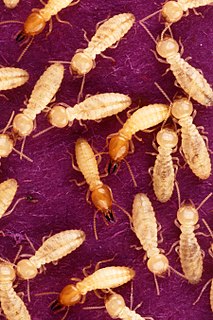
Termites are small insects that live in colonies and have distinct castes (eusocial) and feed on wood or other dead plant matter, occurring on every continent except Antarctica. Termites comprise the infraorder Isoptera, or alternatively the epifamily Termitoidae, within the order Blattodea. Termites were once classified in a separate order from cockroaches, but recent phylogenetic studies indicate that they evolved from cockroaches, as they are deeply nested within the group, and the sister group to wood eating cockroaches of the genus Cryptocercus. Previous estimates suggested the divergence took place during the Jurassic or Triassic. More recent estimates suggest that they have an origin during the Late Jurassic, with the first fossil records in the Early Cretaceous. About 3,106 species are currently described, with a few hundred more left to be described. Although these insects are often called "white ants", they are not ants, and are not closely related to ants.
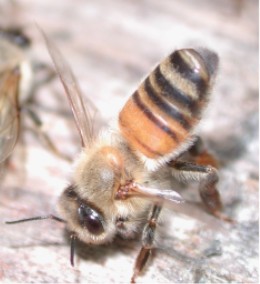
A pheromone is a secreted or excreted chemical factor that triggers a social response in members of the same species. Pheromones are chemicals capable of acting like hormones outside the body of the secreting individual, to affect the behavior of the receiving individuals. There are alarm pheromones, food trail pheromones, sex pheromones, and many others that affect behavior or physiology. Pheromones are used by many organisms, from basic unicellular prokaryotes to complex multicellular eukaryotes. Their use among insects has been particularly well documented. In addition, some vertebrates, plants and ciliates communicate by using pheromones. The ecological functions and evolution of pheromones are a major topic of research in the field of chemical ecology.

The Opiliones are an order of arachnids colloquially known as harvestmen, harvesters, or daddy longlegs. As of April 2017, over 6,650 species of harvestmen have been discovered worldwide, although the total number of extant species may exceed 10,000. The order Opiliones includes five suborders: Cyphophthalmi, Eupnoi, Dyspnoi, Laniatores, and Tetrophthalmi, which were named in 2014.
Chemical ecology is the study of chemically-mediated interactions between living organisms, and the effects of those interactions on the demography, behavior and ultimately evolution of the organisms involved. It is thus a vast and highly interdisciplinary field. Chemical ecologists seek to identify the specific molecules that function as signals mediating community or ecosystem processes and to understand the evolution of these signals. The substances that serve in such roles are typically small, readily-diffusible organic molecules, but can also include larger molecules and small peptides.

Anti-predator adaptations are mechanisms developed through evolution that assist prey organisms in their constant struggle against predators. Throughout the animal kingdom, adaptations have evolved for every stage of this struggle, namely by avoiding detection, warding off attack, fighting back, or escaping when caught.

The term farnesene refers to a set of six closely related chemical compounds which all are sesquiterpenes. α-Farnesene and β-farnesene are isomers, differing by the location of one double bond. α-Farnesene is 3,7,11-trimethyl-1,3,6,10-dodecatetraene and β-farnesene is 7,11-dimethyl-3-methylene-1,6,10-dodecatriene. The alpha form can exist as four stereoisomers that differ about the geometry of two of its three internal double bonds. The beta isomer exists as two stereoisomers about the geometry of its central double bond.
A semiochemical, from the Greek σημεῖον (semeion), meaning "signal", is a chemical substance or mixture released by an organism that affects the behaviors of other individuals. Semiochemical communication can be divided into two broad classes: communication between individuals of the same species (intraspecific) or communication between different species (interspecific).

Megacrania batesii, commonly known as the peppermint stick insect, is an unusual species of stick insect found in northeastern Australia, the Bismarck Archipelago, the Solomon Islands, New Guinea, and possibly as far north as the Philippines. It is notable for its aposematic coloration, as well as its robust chemical defense mechanism. Its common name refers to the irritating fluid — with an odor resembling peppermint — that it sprays as a defensive action from a pair of glands located at its prothorax when threatened, as well as the cylindrical, twig-like shape of its body. A member of the subfamily Megacraniinae, it was first described by English naturalist and explorer Henry Walter Bates in 1865.

The large Japanese field mouse is a nocturnal species of rodent in the family Muridae. It is endemic to Japan.

The harlequin cabbage bug, also known as calico bug, fire bug or harlequin bug, is a black stinkbug of the family Pentatomidae, brilliantly marked with red, orange, yellow and white markings. It is a major pest of cabbage and related crops in the Brassicaceae, as well as the ornamental flower cleome throughout tropical and North America, especially the warmer parts of the United States. Nymphs are active during the summer and in the tropics the bug can achieve three to six generations a year. In the northern range there is only one generation annually and the insects overwinter as adults in crop residues or field edges. Organic control involves hand-picking the insects off the plants and being especially careful to remove and destroy all the eggs, which are black-and-white striped, laid in clutches of twelve.
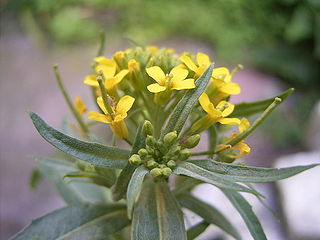
Erysimum cheiranthoides, the treacle-mustard,wormseed wallflower, or wormseed mustard is a species of Erysimum native to most of central and northern Europe and northern and central Asia. Like other Erysimum species, E. cheiranthoides accumulates two major classes of defensive chemicals, glucosinolates and cardiac glycosides.
Insects have a wide variety of predators, including birds, reptiles, amphibians, mammals, carnivorous plants, and other arthropods. The great majority (80–99.99%) of individuals born do not survive to reproductive age, with perhaps 50% of this mortality rate attributed to predation. In order to deal with this ongoing escapist battle, insects have evolved a wide range of defense mechanisms. The only restraint on these adaptations is that their cost, in terms of time and energy, does not exceed the benefit that they provide to the organism. The further that a feature tips the balance towards beneficial, the more likely that selection will act upon the trait, passing it down to further generations. The opposite also holds true; defenses that are too costly will have a little chance of being passed down. Examples of defenses that have withstood the test of time include hiding, escape by flight or running, and firmly holding ground to fight as well as producing chemicals and social structures that help prevent predation.

Plant use of endophytic fungi in defense occurs when endophytic fungi, which live symbiotically with the majority of plants by entering their cells, are utilized as an indirect defense against herbivores. In exchange for carbohydrate energy resources, the fungus provides benefits to the plant which can include increased water or nutrient uptake and protection from phytophagous insects, birds or mammals. Once associated, the fungi alter nutrient content of the plant and enhance or begin production of secondary metabolites. The change in chemical composition acts to deter herbivory by insects, grazing by ungulates and/or oviposition by adult insects. Endophyte-mediated defense can also be effective against pathogens and non-herbivory damage.

Anisomorpha buprestoides, the southern two-striped walkingstick, devil rider, or musk mare, is a stick insect which occurs throughout the southeastern United States.
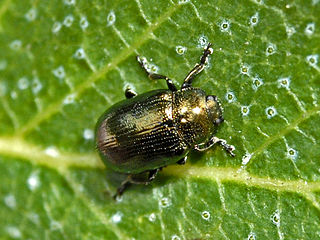
Phratora vitellinae, the brassy leaf beetle, formerly Phyllodecta vitellinae, is a beetle of the family Chrysomelidae found in Europe and Asia. It feeds on Populus and Salix species. The evolution of its host plant preferences and the mechanism by which it uses host plant chemicals to make a larval defensive secretion have been the subject of intense study by research groups in Europe and the Nordic countries.

Phagomimicry is a defensive behaviour of sea hares, in which the animal ejects a mixture of chemicals, which mimic food, and overwhelm the senses of their predator, giving the sea hare a chance to escape. The typical defence response of the sea hare to a predator is to release two chemicals - ink from the ink gland and opaline from the opaline gland. While ink creates a dark, diffuse cloud in the water which disrupts the sensory perception of the predator by acting as a smokescreen and as a decoy, the opaline, which affects the senses dealing with feeding, causes the predator to instinctively attack the cloud of chemicals as if it were indeed food. This ink is able to mimic food by having a high concentration of amino acids and other compounds that are normally found in food, and the attack behaviour of the predator allows the sea-hares the opportunity to escape.

Social immunity is any antiparasite defence mounted for the benefit of individuals other than the actor. For parasites, the frequent contact, high population density and low genetic variability makes social groups of organisms a promising target for infection: this has driven the evolution of collective and cooperative anti-parasite mechanisms that both prevent the establishment of and reduce the damage of diseases among group members. Social immune mechanisms range from the prophylactic, such as burying beetles smearing their carcasses with antimicrobials or termites fumigating their nests with naphthalene, to the active defenses seen in the imprisoning of parasitic beetles by honeybees or by the miniature 'hitchhiking' leafcutter ants which travel on larger worker's leaves to fight off parasitoid flies. Whilst many specific social immune mechanisms had been studied in relative isolation, it was not until Sylvia Cremer et al.'s 2007 paper "Social Immunity" that the topic was seriously considered. Empirical and theoretical work in social immunity continues to reveal not only new mechanisms of protection but also implications for understanding of the evolution of group living and polyandry.

The giant mesquite bug is an insect of the order Hemiptera, or the "true bugs". As a member of the family Coreidae, it is a leaf-footed bug. As the common name implies, it is a large bug that feeds on mesquite trees of the American Southwest and Northwestern Mexico.

Mushroom-feeding Drosophila are a subset of Drosophila flies that have highly specific mushroom-breeding ecologies. Often these flies can tolerate toxic compounds from Amanita mushrooms.
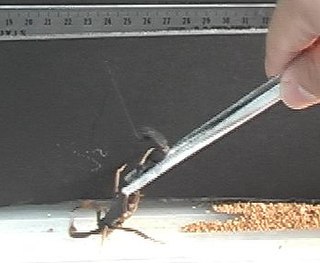
Toxungen comprises a secretion of one or more biological toxins that is transferred by one animal to the external surface of another animal via a physical delivery mechanism. Toxungens can be delivered through spitting, spraying, or smearing. As one of three categories of biological toxins, toxungens can be distinguished from poisons, which are passively transferred via ingestion, inhalation, or absorption across the skin, and venoms, which are delivered through a wound generated by a bite, sting, or other such action. Toxungen use offers the evolutionary advantage of delivering toxins into the target's tissues without the need for physical contact.
























